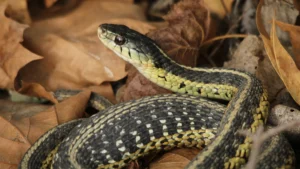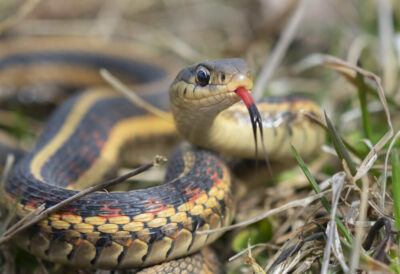Are garter snakes poisonous? This seemingly straightforward question often sparks curiosity and concern among those encountering these slender reptiles. Garter snakes, ubiquitous across various habitats, possess a distinct appearance and behavior that invites inquiry into their potential danger to humans and other animals.Garter snakes, despite their often vivid and striking appearance, are not poisonous to humans. They belong to a group of snakes known as colubrids, which typically rely on constriction rather than venom to subdue their prey.
While garter snakes do produce a mild venom, it is not harmful to humans. Instead, they primarily feed on small amphibians, insects, and other small prey items. However, it’s essential to handle all wildlife with care and respect, including garter snakes, to avoid causing unnecessary stress or harm to the animals.
Are garter snakes poisonous?

Garter snakes are not poisonous; instead, they are mildly venomous. This means that they do produce toxins in their saliva, but these toxins are not harmful to humans. Garter snakes use their venom primarily to subdue their prey, which typically consists of small animals such as insects, worms, and small amphibians.
When they bite humans, it’s usually in self-defense, and the bite may cause minor irritation or swelling, similar to a bee sting. However, their venom is not potent enough to pose a significant threat to human health. Overall, garter snakes are considered harmless to humans and are even beneficial due to their role in controlling pest populations.
Defensive Mechanisms of Garter Snakes
Garter snakes, like many other snake species, have several defensive mechanisms to protect themselves from potential threats:
- Camouflage: Garter snakes often have colors and patterns that help them blend into their surroundings, making them less visible to predators.
- Foul-smelling Secretions: When threatened, garter snakes can emit a foul-smelling musk from glands near their tail. This odor serves as a deterrent to predators.
- Hissing and Vibrating Tail: Garter snakes may hiss and vibrate their tails when threatened. This behavior can mimic the sound of a rattlesnake, deterring potential predators.
- Bite: While garter snakes are not aggressive, they may resort to biting as a defensive measure if they feel threatened or cornered. Their bites are generally harmless to humans, but they may cause minor irritation or swelling.
- Fleeing: When confronted with a threat, garter snakes often prefer to flee rather than engage in confrontation. They are swift and agile, allowing them to quickly escape from danger.
These defensive strategies help garter snakes avoid predation and survive in their natural habitat.
Human Interactions with Garter Snakes
Human interactions with garter snakes can vary depending on cultural attitudes, individual preferences, and geographic location. Here are some common ways in which people interact with garter snakes:
- Observation: Many people encounter garter snakes in their natural habitats while hiking, gardening, or exploring outdoor spaces. Observing these snakes in the wild can be a fascinating and educational experience for nature enthusiasts.
- Pet Keeping: Some people keep garter snakes as pets. Garter snakes are relatively easy to care for, and their small size and docile nature make them popular reptile pets. Captive-bred garter snakes are often available in the pet trade.
- Education and Research: Garter snakes are often used in educational programs and scientific research. Zoos, nature centers, and educational institutions may keep garter snakes for educational purposes, allowing people to learn about their biology, behavior, and ecological importance.
- Fear and Misunderstanding: Despite their harmless nature, some people fear garter snakes due to a general aversion to snakes or misinformation about their behavior. This fear can lead to negative interactions, such as attempts to kill or remove garter snakes from their habitats.
- Conservation Efforts: Garter snakes play important roles in ecosystems as both predators and prey. Conservation efforts may focus on protecting garter snake habitats, studying population dynamics, and raising awareness about the importance of these snakes in maintaining ecosystem health.
- Citizen Science: Citizen science projects often involve the public in collecting data on garter snake populations. This data can contribute to our understanding of garter snake distribution, abundance, and behavior, helping researchers make informed conservation decisions.
Overall, human interactions with garter snakes can range from appreciation and curiosity to fear and misunderstanding. Encouraging respect for these fascinating reptiles and their natural habitats is essential for promoting coexistence and conservation.
Can garter snakes be beneficial to their environment?

Yes, garter snakes can be beneficial to their environment in several ways:
- Pest Control: Garter snakes primarily feed on small prey such as insects, slugs, snails, and small rodents. By keeping populations of these potential pests in check, garter snakes help maintain ecological balance and prevent damage to crops and gardens.
- Prey for Predators: Garter snakes serve as an important food source for various predators, including birds of prey, larger snakes, mammals, and even some fish. Their presence in the food chain contributes to the overall biodiversity and stability of ecosystems.
- Seed Dispersal: Garter snakes may inadvertently assist in seed dispersal by ingesting fruits or seeds and then depositing them in different locations through their feces. This process helps plants spread and colonize new areas, contributing to ecosystem diversity.
- Ecosystem Health Indicators: Garter snakes are sensitive to changes in their environment, including habitat loss, pollution, and climate change. Monitoring garter snake populations can provide valuable insights into the health of ecosystems and the impacts of human activities.
- Nutrient Cycling: Like all organisms, garter snakes play a role in nutrient cycling by consuming organic matter and releasing nutrients back into the soil through their waste. This process contributes to soil fertility and overall ecosystem productivity.
Overall, garter snakes play important ecological roles as predators, prey, and contributors to nutrient cycling. Protecting garter snake habitats and promoting coexistence with these beneficial reptiles can help maintain healthy and resilient ecosystems.
Common misconceptions about garter snakes and their toxicity
Garter snakes are often misunderstood, leading to several misconceptions about their toxicity and behavior. Here are some common misconceptions:
- All Snakes are Venomous: Many people mistakenly believe that all snakes are venomous and pose a threat to humans. While some snakes, such as vipers and cobras, are venomous and can be dangerous, the vast majority of snake species, including garter snakes, are non-venomous. Garter snakes are harmless to humans and rely on constriction rather than venom to subdue their prey.
- Garter Snakes are Aggressive: Garter snakes are generally docile and non-aggressive towards humans. When threatened, they may release a foul-smelling musk and attempt to escape rather than confront or attack. Garter snakes are more likely to flee than to exhibit aggressive behavior.
- Garter Snakes are Highly Toxic: While garter snakes do produce toxins, they are not considered highly toxic to humans. The toxins produced by garter snakes are relatively mild and are primarily used for defense against predators. Garter snake venom is not potent enough to cause significant harm to humans and typically only results in minor irritation if it comes into contact with the skin.
- Garter Snakes are Disease Carriers: Some people mistakenly believe that garter snakes are carriers of diseases harmful to humans, such as salmonella. While it is true that all reptiles, including garter snakes, can carry salmonella bacteria, the risk of contracting salmonella from garter snakes is relatively low with proper hygiene practices, such as washing hands after handling them.
- Garter Snakes are Harmful to Pets: Garter snakes are not typically harmful to pets such as cats and dogs. While pets may show interest in garter snakes and attempt to interact with them, garter snakes are not aggressive towards larger animals and are more likely to flee than to pose a threat.
Overall, garter snakes are harmless and beneficial reptiles that play important roles in ecosystems. Understanding and dispelling common misconceptions about garter snakes can promote appreciation for these fascinating creatures and encourage coexistence with them in their natural habitats.
Conclusion
Get all you need to know on the question are garter snakes poisonous. Garter snakes are not poisonous. Despite common misconceptions, these reptiles are non-venomous and pose no significant threat to humans.
While they do produce mild toxins for self-defense, these toxins are not harmful to humans and typically only cause minor irritation.
Understanding the true nature of garter snakes, and recognizing that they are not poisonous, is essential for promoting coexistence and appreciation for these harmless and beneficial creatures in their natural habitats. Therefore, it’s important to recognize that garter snakes are not poisonous and play valuable roles in maintaining healthy ecosystems.

